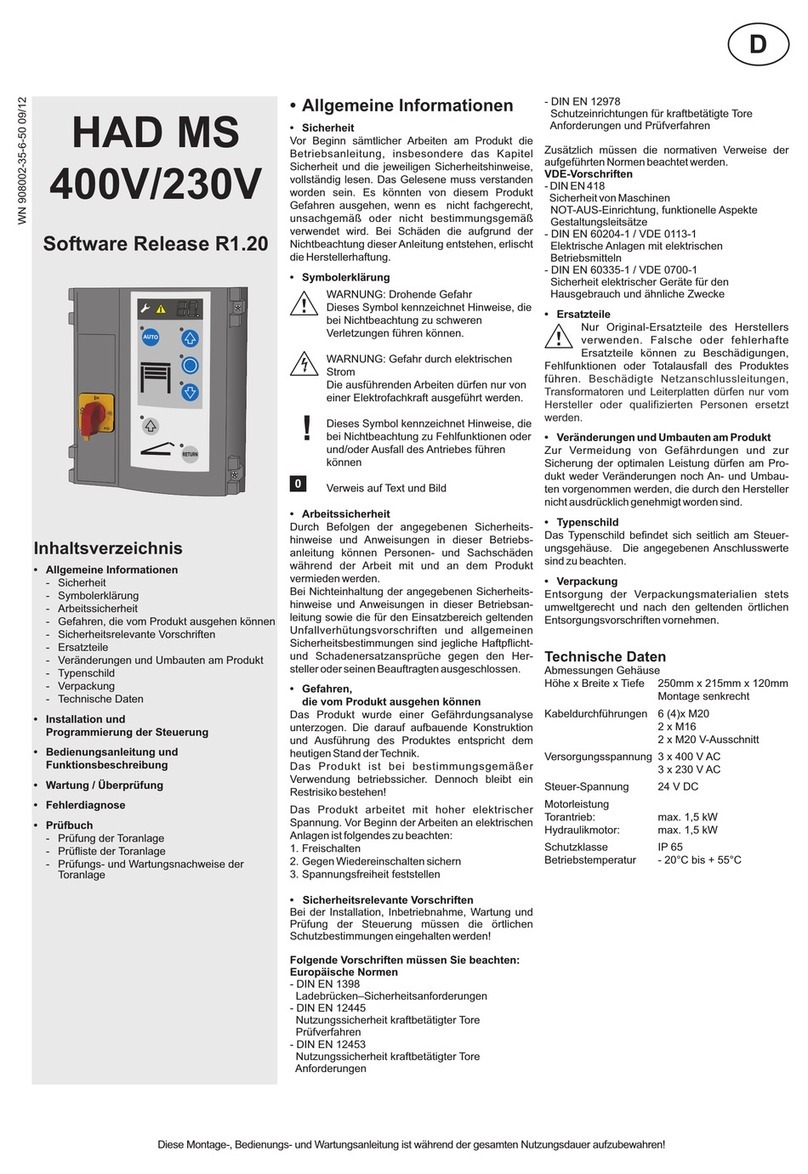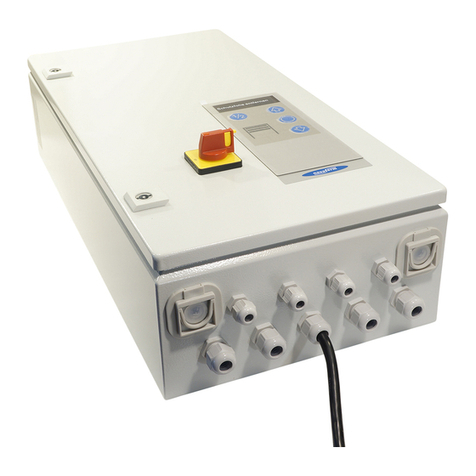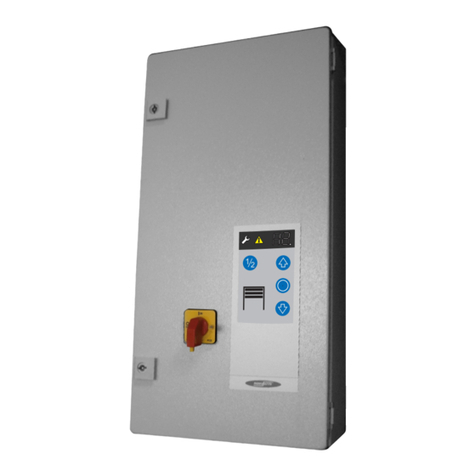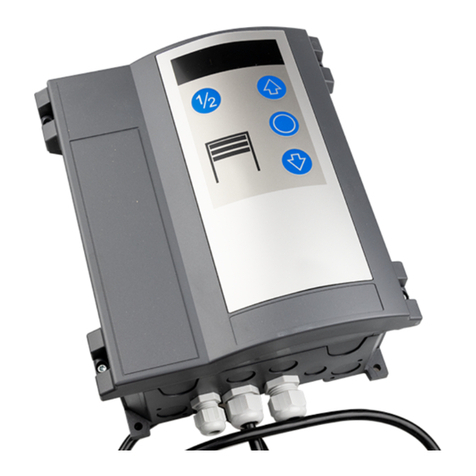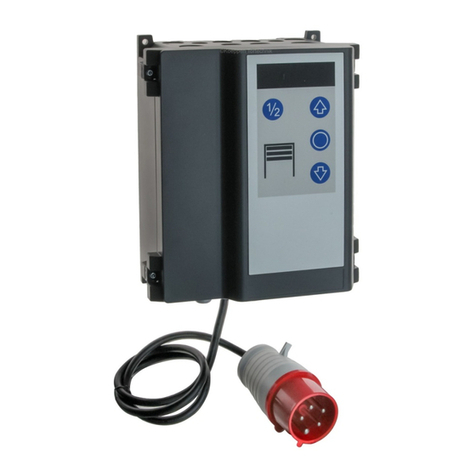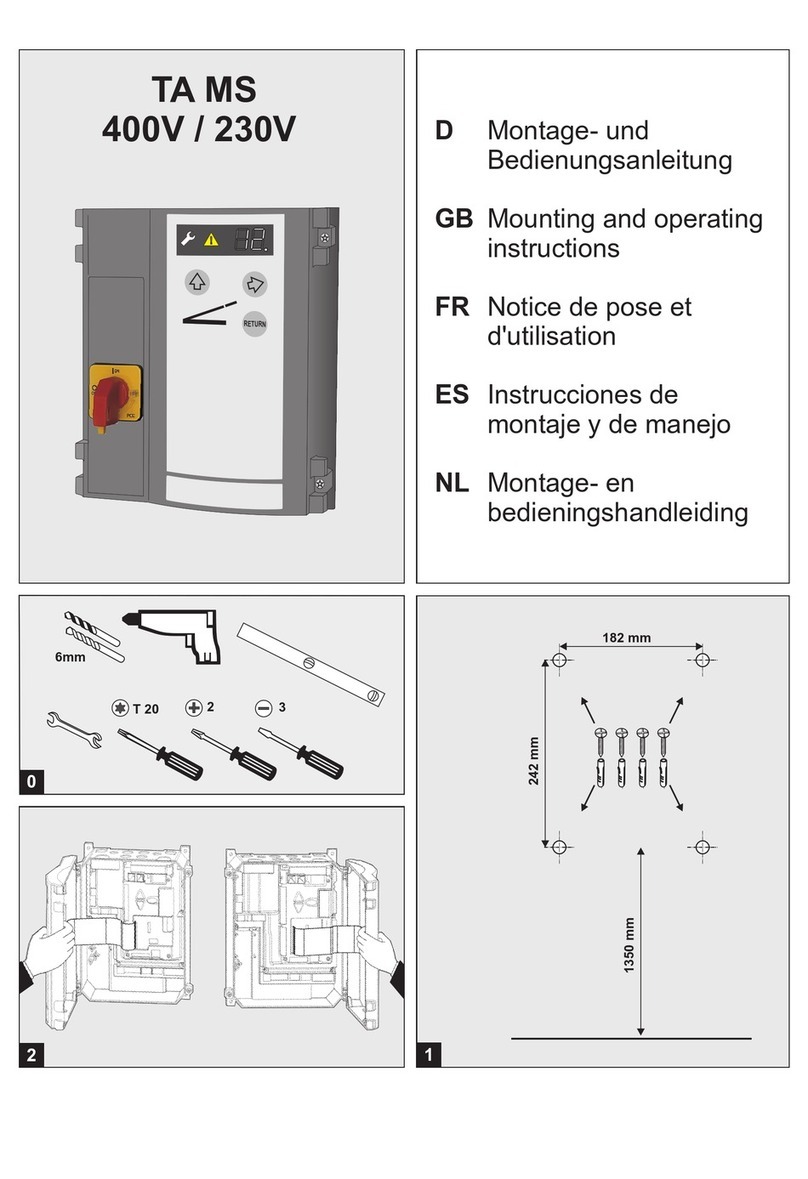
Installation
Benötigte Werkzeuge
Montage Steuerung
Öffnen der Steuerungsabdeckung
Anschlüsse
Benennung:
J1 Start / Impuls-Eingang (AUF / HALT / ZU)
J2 Sicherheitslichtschranke 2- oder 4-Draht
J3 Schließkantensicherung OSE / 8K2 / DW
J4 Not-Aus-Taster, Schlaffseil, Verriegelung
J7 Schlüsseltaster / Zugschalter
J9 Digitaler Endschalter - Motorkabel
J10 Anschluss Erweiterungssteuerungen
J11 Anschluss Funkempfänger
J12 Antenne
J13 Folientastatur
X1 Netzanschluss
X2 Netzausgang L, N (500 W / 230 V)
X3 Schutzleiterkontakt
X5 Potentialfreier Relais Kontakt 1,
Torstatusrelais
X6 Potentialfreier Relais Kontakt 2,
Torstatusrelais
X7 Torantrieb
X8 24V DC, max. 200mA
Netzanschluss
Die Steuerung ist mit einem CEE-Stecker 16A und
ca. 1m Kabel anschlussfertig entsprechend 4a
verdrahtet.
Netzanschluss muss entsprechend der
vorhandenen Netzspannung ausgeführt
!werden.
Motoranschlussleitung
Die Anschlussleitung ist für Motor und digitalen
Endschalter DES vorkonfektioniert - aufstecken.
Anschluss für Impulsgeber
6a/6b - Anschluss J1 für externe Befehlsgeber
Auf, Halt und Zu.
6c - Schaltfolge Auf-Halt-Zu, im Menü 51 den Wert 1
einstellen.
J1.3 - , -½ Toröffnung J1.4 volle Toröffnung
6d - Anschluss J7, Schaltfolge Auf-Zu
(Menü 50, Werkseinstellung) siehe auch
Betriebsanleitung Funktion Schlüsselschalter
Das Tor muss von dem Ort der
Bedienung aus einsehbar sein.
Anschluss für Lichtschranke
Im Menü 36 muss die Lichtschranke entsprechend
eingestellt werden.
7a 2-Drahtlichtschranke Ls2
Dabei darf die Schließfahrt nicht gestört
werden um keine falsche Position zu
erfassen.
7b 4-Drahtlichtschranke LS5 mit Testung
7c Reflexionslichtschranke
Wenn im Menü die Lichtschranke in der Zarge
montiert ausgewählt wurde, führt die Steuerung bei
der nächsten Fahrt in Zu eine Lernfahrt zur
Positionserkennung durch.
Anschluss für Schließkantensicherung
Bei Impulsbetrieb Zu ist eine Schliesskanten-
sicherung anzuschließen. Entsprechende im Menü
35 auswählen. Durch langen Tastendruck der Prog-
Taste auf Menü 35 wird der gemessene
Widerstandswert der 8K2 Schließkante angezeigt.
Bsp.: 82 bedeutet 8k2. Durch kurzes Betätigen der
Prog-Taste wird die Anzeige abgebrochen.
8a optische Schießkantensicherung OSE.
Elektrische Schließkantensicherung 8K2
mit 8,2 KOhmAbschlusswiderstand (Wert = 1).
Elektrische Schließkantensicherung 8K2 in
Reihenschaltung mit Schlaffseil- und
Schlupftürschalter (Wert = 3)
0
1
2
3
4
5
6
7
8
8b Druckwellenleiste und -Schalter mit
8,2 KOhm Schleifenwiderstand (Wert = 2)
Die Druckwellenleiste nur mit Testung
betreiben. Hierzu Menü 35 = 2 auswählen.
Anschluss Not-Halt
Anschluss Schlüsselschalter / Zugschalter
Bei Verwendung eines Schlüsselschalters /
Zugschalters ist im Menü 50 die gewünschte
Funktion auszuwählen.
Funkfernsteuerung
Empfängermodul (Option) auf J11 aufstecken und im
Menü 60, 61 oder 62 Handsender einlernen.
Relaisausgänge
2 Wechslerkontakte max. belastbar: 250VAC / 2A
oder 24VDC / 1A. Der 24V-Ausgang an X8 darf max.
mit 200mA belastet werden. Die Relaisfunktion ist in
den Menü 45 und 46 auszuwählen.
Ist in Menü 40 der AR-Betrieb (Menü 3 oder 4)
ausgewählt, dann ist X6 die Funktion Vorwarnlicht
zugeordnet. Die Einstellungen in Menü 46 sind
unwirksam.
12b Gegenseitige Verriegelung von 2 Toren
(Schleusenschaltung) Menü 50 Wert 2 oder 3 und.
Menü 45 Wert 0.
12c Gegenseitige Verriegelung von 3 Toren
(Schleusenschaltung) Menü 50 Wert 2 oder 3 und.
Menü 45 und 46 Wert 0.
13 Lichtgitter
Alternativ zur Schließkantensicherung kann ein
Lichtgitter verwendet werden. Hierzu ist das
Lichtgitter der Zeichnung 13a, 13bentsprechend
anzuklemmen. Menü 35 = 0 einstellen.
Programmieren der
Steuerung
Die Programmierung ist menügesteuert.
Toreinstellung bitte entsprechend dem Schema
durchführen. Nachfolgende Seite zeigt den
kompletten Menüumfang.
Einstellen Torendlagen (Menü 30 und 31)
Abhängig vom Antrieb muss das Tor feder-
!ausgeglichen sein.
Die obere und untere Endlage müssen direkt nach
einander eingestellt werden.
Nachlaufwegkorrektur (Menü 42)
Gleicht Veränderungen der Zuposition aus, die durch
Temperatur, Einlaufen des Getriebes usw. herrühren.
Bodenanpassung (Menü 43)
Gleicht Veränderungen der Zuposition aus, die durch
Seillängung bzw. durch Anheben des Fußbodens
entstehen. Die Endlage Zu wird durch die
Bodenberührungen der Schließkantesicherung
angepasst.
Zuvor erst genaue Zuposition einstellen, anschlies-
send Menü 43 einstellen.
In den Einstellungen 2, 3 und 4 werden die
eingelernten Positionen aus Menüs 31, 34 und 37
entsprechend angepasst.
Federbrucherkennung (Menü 47)
Bei Überschreitung des eingestellten Wertes wird
Fehl er F32 angezeigt.
Nach dem Erneuern der Federn sind die
Torendlagen neu einzustellen.
!
Motor 9.24/5.24: Eingabewert = U x Gewicht / 20Kg
Motor 9.20: Eingabewert = U x Gewicht / 16Kg
Motor 9.15: Eingabewert = U x Gewicht / 15Kg
Beispiel:
Motor 9.24, U = 8 Umdrehungen für Toröffnung
Torblattgewicht = 150Kg, bei 2 Federn trägt jede
75Kg. DieAbschaltung soll bei 60Kg erfolgen.
9
10
11
12
Eingabewert 24= 8 x 60Kg / 20Kg =
Einstellung ist bei Schnellentriegelung
erforderlich, andernfalls sind
Federbruchschalter anzuschließen.
Prüfung Federausgleich
Nachdem das Tor einmal komplett auf und zuge-
fahren wurde, Menü 47 anstatt kurz, die Taste 5
Sekunden lang drücken.
Wert gibt an, wie das Tor ausbalanciert ist:
Motor 9.24/5.24: F (Kg) = Anzeigewert x 20Kg / U
Motor 9.20: F (Kg) = Anzeigewert x 16Kg / U
Motor 9.15: F (Kg) = Anzeigewert x 15Kg / U
U = Anzahl der Umdrehungen für eine Toröffnung
Wenn Anzeigewert -2 bis -9, dann sind Federn zu
stark gespannt.
Die Ergebnisse sind nur annäherungsweise zu
betrachten. Zur genaueren Bestimmung ist eine
Kraftmessfahrt durchzuführen.
Bei Verwendung von 6.65DU weicht die Funktion
ab. Hierzu bitte den Abschnitt “Funktion
!DU”berücksichtigen.
Öffnungskraftbegrenzung (Menü 48)
Die Öffnungsfahrten werden mit der vorherigen
Fahrt verglichen. Bei Überschreitung mit dem
eingestellten Wert stoppt das Tor und F33 erscheint.
Das Tor kann anschließend nur im Totmann-
betrieb zugefahren werden. Ursache der
!Kraftüberschreitung beseitigen und danach das
Tor auf und zufahren.
Motor 9.24/5.24: Eingabewert = U x Gewicht / 20Kg
Motor 9.20: Eingabewert = U x Gewicht / 16Kg
Motor 9.15: Eingabewert = U x Gewicht / 15Kg
Die Ergebnisse sind nur annäherungsweise zu
betrachten. Zur genaueren Bestimmung ist eine
Kraftmessfahrt durchzuführen.
Bei Verwendung von 6.65DU weicht die Funktion
ab. Hierzu bitte den Abschnitt “Funktion
!DU”berücksichtigen.
Kraftmessfahrt
zur Bestimmung der Abschaltschwelle.
Nach Eingabe des Wertes 99 im Menü 48 führt die
Steuerung eine Kraftmessfahrt durch:
1. Ein Prüfgewicht (empfohlen ca. 20Kg) am Tor
befestigen und Tor komplett auf und zufahren.
2.Anschließend erscheint im Menü 48 der Wert
und wird alsAbschaltwert übernommen. Der
Wert kann geändert werden (doppelter Wert
gleich doppelte Kraft).
3. Prüfgewicht wieder entfernen und Tor wieder auf
und zufahren.
Einschaltdauer (Menü 49)
Die eingestellte Einschaltdauer verhindert die
Überhitzung des Antriebsmotors und vermeidet
Schäden.
Bei Einsatz des Motors 5.24 mit Kunststoff-
getriebe muss die Einschaltdauer auf 1 (3~) oder
!auf 2 (WS, 1~) eingestellt werden.
RWA-Funktion (Rauch-Wärme-Abzug)
Im Menü 55 die entsprechende Torposition
einstellen. Brandmeldeanlage an J7 anschließen
und im Menü 50 Wert 9 einstellen.
Auswahl Steuerungstyp (Menü 59)
In Menü 59 werden verschiedene Steuerungstypen
ausgewählt. Entsprechende Einstellungen sind den
Zusatzblättern zu entnehmen.

